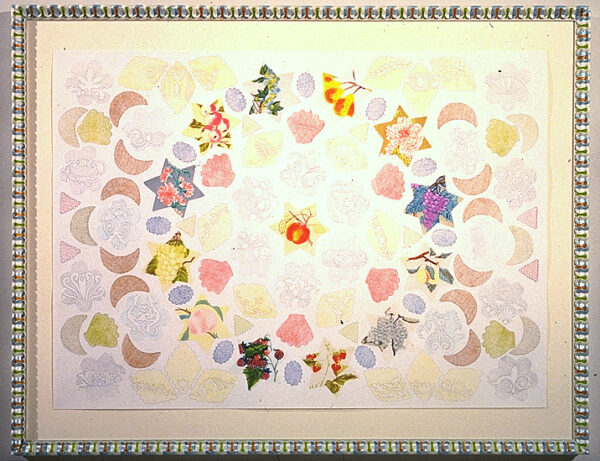Joyce Kozloff is an artist who was a leader of the Pattern and Decoration movement and was involved in the feminist art movement, both of which took place during the 1970s. Her work is influenced by both culture and cartography. Kozloff was born in 1942 in New Jersey and has two younger brothers. Her parents’ families emigrated from Lithuania. Kozloff studied at the Art Students League in New York, Rutgers University, and Universita di Firenze during the summers of 1959, 1962, and 1963, respectively. She earned a BFA from the Carnegie Mellon University in 1964 and her MFA from Columbia University in 1967. That year, she married Max Kozloff, a distinguished art historian, critic, and photographer. They have one son, Nikolas Kozloff, who was born in 1969.
Kozloff was living in Los Angeles for a year in 1971 when she and other women formed the Los Angeles Council of Women Artists. The group organized the first protests to the absence of women in the Los Angeles County Museum of Art’s exhibitions and collections. “For us, there weren’t women in the galleries and museums, so we formed our own galleries, we curated our own exhibitions, we formed our own publications, we mentored one another, we even formed schools for feminist art. We examined the content of the history of art, and we began to make different kinds of art forms based on our experiences as women. So it was both social and something even beyond; in our case, it came back into our own studios,” Kozloff explained. She was also a founding member of the Heresies Collective, a group that produced a quarterly magazine titled Heresies: A Feminist Publication on Art and Politics.
Kozloff is interested in the artistic traditions of different countries, especially Mexico, Turkey, and Morocco, all of which she has visited. She studied books on Islamic patterning, and became absorbed in the historic significance of repeated designs. She was particularly impressed by the decorative arts that were mostly created by anonymous women and people of color throughout history. In 1973, she began making large paintings that she hoped would “break down the western hierarchy between high art and decoration.” She started meeting with artists including Tony Robbin, Robert Kushner, and Robert Zakanitch, and together they formed the Pattern and Decoration movement in 1975.
During the ‘80s, Kozloff focused on creating murals, which she had become interested in while studying under Robert Lepper during her time at Carnegie Mellon. Her first public mural was an 83-foot-long piece composed of glazed ceramic tiles produced for the Harvard Square Subway Station in Massachusetts. Between 1979 and 2003, she completed fifteen major public art commissions. In each commission, Kozloff incorporated site-specific images that reflected on the cultural history of the city. She has said that she wanted to make art accessible to everyone by removing it from the confines of “elitist” private collections or museums.
Kozloff started using maps as the basis of her work in the early 1990s. “I luxuriate in the sheer beauty of maps, as incised diagram and reflection of our world,” she has written, and added that “Co-existing social concerns have been with me from my beginnings as a young feminist artist: how to create an art that is both graphically satisfying and intellectually questioning.” Kozloff has also created a series of artist’s books that contain drawings, watercolors, and collages. Her first book, Patterns of Desire—Pornament is Crime, was published by Hudson Hills Press in 1990 with an introductory essay by Linda Nochlin. Robert Kushner wrote an introductory essay for Kozloff’s next book Boy’s Art, a series of twenty-four drawings based on illustrations and maps depicting historic battles, over which she collaged copies of her son Nikolas’s childhood drawings and details from old master paintings. It was published by Distributed Art Publishers in 2003. In 2010, Charta Books Ltd. published Kozloff’s third artist’s book, China is Near, which included photographs, charts, and a conversation with Barbara Pollack.
Joyce Kozloff’s honors include the Lifetime Achievement Award from the Women’s Caucus for Art; two National Endowment for the Arts Individual Artist grants, one for painting and one for drawing; and a John Simon Guggenheim Memorial Foundation fellowship. Her work is held in the collections of the Los Angeles County Museum of Art; the M.H. de Young Memorial Museum, San Francisco; the National Gallery of Art, Washington DC; the Museum of Modern Art and the Whitney Museum of American Art, New York. She is represented by DC Moore Gallery in New York City, where she and her husband Max Kozloff live and work.
–Carleigh Koger

